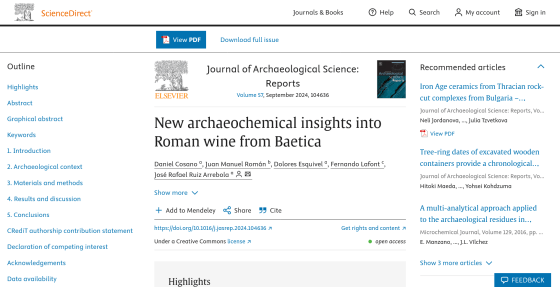World's oldest known wine discovered in Spain contains unexpected ingredient

In 2019, a 2,000-year-old jar was discovered in the city of Carmona in southern Spain. The jar was intact and perfectly sealed, and was found to contain a liquid that was later found to be wine, but along with the liquid, it was discovered to contain something surprising.
New archaeochemical insights into Roman wine from Baetica - ScienceDirect

World's oldest wine discovered in southern Spain
During restoration work on a private house in Carmona in 2019, a structure believed to be an ancient Roman cemetery was discovered. The tomb, measuring 1.73m wide by 3.29m long, is thought to date to around the 1st century AD and is probably a family tomb.

There were eight small spaces on either side of the entrance wall, two of which were empty and six of which contained vases.

The jars contained offerings and amber beads used in burial rituals, but one of them was found to contain a reddish liquid that was later found to be possibly 'white wine' and that contained 'remains of the dead.'
The researchers who examined the urn pointed out, 'Given the religious significance of wine in the ancient Roman world, it was highly symbolic and closely linked to burial rituals. In fact, it is believed that wine was usually placed in burial goods, along with food such as water and honey, as an offering with the hope that the deceased would pass on to a better world. Therefore, the reddish liquid found in this urn is undoubtedly wine, or perhaps the remains of wine that has spoiled over the years.'
So far, the oldest known wine preserved in liquid form is the 'Speyer Wine Bottle' discovered in Speyer, Germany, which is thought to be about 1,700 years old. If the liquid discovered this time is confirmed to be wine, the world's oldest record of wine will go back about 300 years.

Although it was not possible to identify the origin of the liquid, analysis of the minerals contained in it suggests that it may be comparable to sherry, which is still produced today in Jerez, a city located south of Carmona.
According to the researchers, the tomb was filled with ornaments suitable for a high-ranking person, so it was probably the tomb of a wealthy family. Some of the vases were empty, while others contained rings and perfume remnants, which are thought to have been buried for the deceased to use in the afterlife. The bones found with the liquid were male, which is natural because 'women were forbidden to drink wine in ancient Rome.'
'In ancient Rome, as in other societies, death had a special meaning, and those left behind wanted to remember the dead in some way,' the researchers said. 'After the remains were placed in the urn, the urn would likely have been filled with wine as a kind of ritual or to help the deceased transition to a better world.'
Related Posts:
in Science, Posted by log1p_kr







